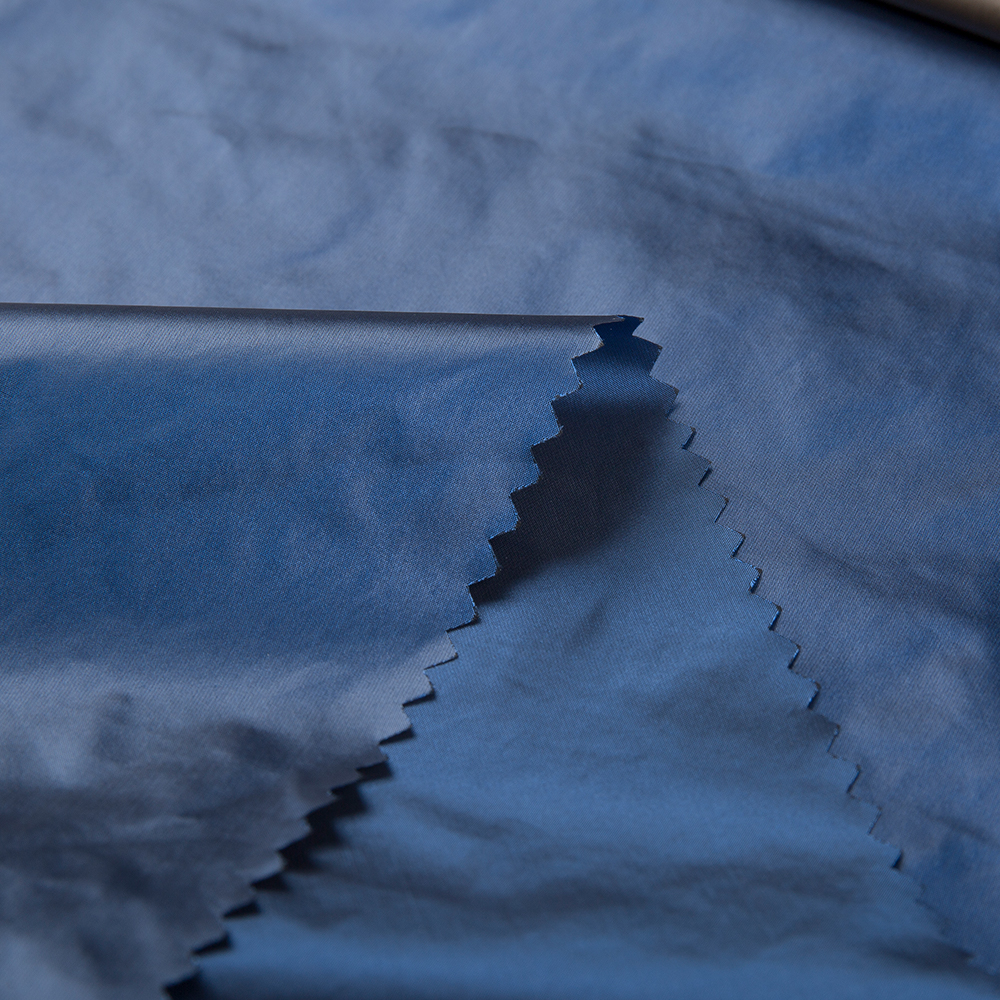The coating or treatment of nylon taffeta fabric can significantly enhance or modify its performance characteristics, making it suitable for a variety of specialized applications. Here’s how different coatings and treatments affect nylon taffeta:
1. Water Resistance
Coating: Treatments such as Durable Water Repellent (DWR) or polyurethane (PU) coatings are commonly applied to nylon taffeta to improve its water resistance. These coatings create a barrier that prevents water from penetrating the fabric.
Impact: Enhanced water resistance makes nylon taffeta suitable for use in outdoor gear like rain jackets, tents, and backpacks. It helps keep the wearer dry and protects the fabric from water damage.
2. UV Protection
Coating: UV-resistant coatings can be applied to nylon taffeta to protect it from the harmful effects of ultraviolet (UV) radiation. These coatings help reduce fabric degradation caused by prolonged sun exposure.
Impact: UV protection extends the lifespan of nylon taffeta when used in outdoor settings, such as for awnings, outdoor furniture, and sunshades. It prevents fading and deterioration from sun exposure.
3. Enhanced Durability
Coating: Reinforcement treatments, such as silicone or acrylic coatings, can improve the durability of nylon taffeta. These coatings enhance the fabric’s resistance to abrasion, tearing, and general wear and tear.
Impact: Increased durability makes nylon taffeta suitable for high-stress applications, such as in backpacks, luggage, and protective gear. It helps the fabric withstand rough handling and environmental conditions.
4. Flame Retardancy
Treatment: Flame-retardant treatments can be applied to nylon taffeta to make it resistant to ignition and slow the spread of flames. These treatments involve adding chemical agents that inhibit flammability.
Impact: Flame-retardant nylon taffeta is used in applications where fire safety is a concern, such as in fire-resistant clothing, safety equipment, and certain industrial applications.
5. Breathability
Coating: While coatings that enhance water resistance can reduce breathability, some treatments are designed to balance water resistance with breathability. These treatments allow moisture vapor to escape while keeping water out.
Impact: Improved breathability enhances comfort for users, especially in activewear and outdoor gear. It prevents moisture buildup and maintains a comfortable microclimate next to the skin.
6. Surface Finish
Coating: Coatings can be applied to modify the surface finish of nylon taffeta, giving it a glossy or matte appearance. This affects both the aesthetic and functional properties of the fabric.
Impact: A glossy finish can enhance the fabric’s visual appeal, making it suitable for fashion and decorative applications. A matte finish may be preferred for a more subdued appearance or for specific functional purposes.

7. Anti-Microbial Treatment
Treatment: Anti-microbial treatments can be applied to nylon taffeta to inhibit the growth of bacteria, mold, and fungi. These treatments are often used in environments where hygiene is a concern.
Impact: Anti-microbial nylon taffeta is beneficial for applications such as medical textiles, sportswear, and camping gear. It helps prevent odors and maintains cleanliness.
8. Static Reduction
Treatment: Anti-static treatments can be applied to reduce the buildup of static electricity on nylon taffeta. This is important for applications where static control is needed, such as in electronics or certain industrial environments.
Impact: Reduced static buildup helps prevent dust attraction and static discharge, which is critical for applications requiring static-free conditions.
9. Colorfastness
Treatment: Coatings and treatments can improve the colorfastness of nylon taffeta, ensuring that colors remain vibrant and do not fade over time.
Impact: Enhanced colorfastness is important for aesthetic applications where long-lasting color integrity is desired, such as in fashion and branding.
Coatings and treatments applied to nylon taffeta fabric can greatly enhance its performance by improving water resistance, UV protection, durability, flame retardancy, breathability, surface finish, anti-microbial properties, static reduction, and colorfastness. These modifications tailor the fabric for specific uses, making it versatile for a wide range of applications from outdoor gear to fashion and industrial uses. Each treatment addresses different needs and conditions, optimizing the fabric’s suitability for its intended purpose.











